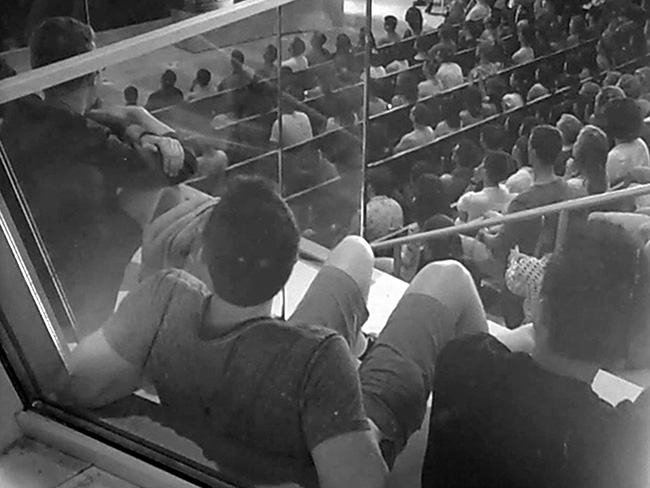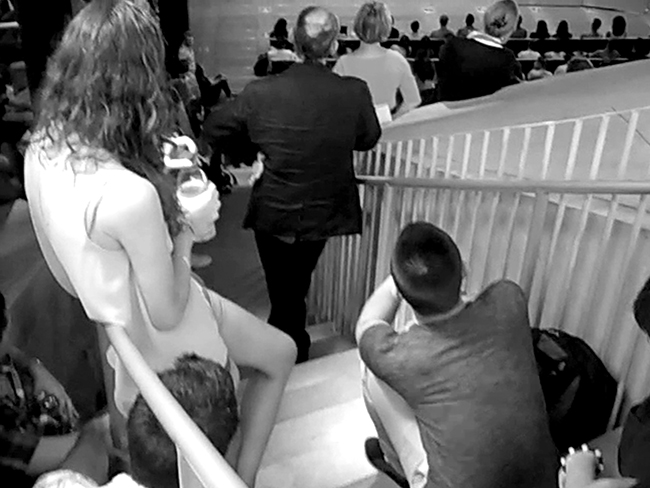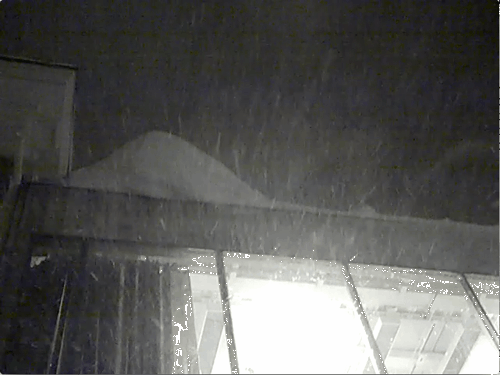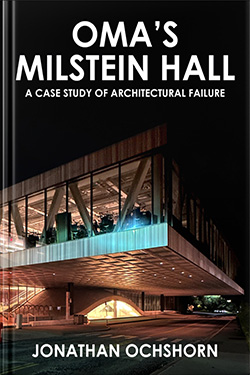contact | contents | bibliography | illustration credits | ⇦ chapter 11 |
12. DANGEROUS DETAILS
The first and last word on dangerous architectural details is Monty Python's legendary "Architects Sketch," whose satirical architectural proposal for an apartment building was excerpted in the opening paragraph of my book, Building Bad: "The tenants arrive in the entrance hall here, are carried along the corridor on a conveyor belt in extreme comfort and pass murals depicting Mediterranean scenes towards the rotating knives…"1
One might wonder why architects—at least those who are not engaged in satire or parody—would create buildings that could cause injury. In most cases, the answer seems to be a pathologically narrow focus on how building elements appear—i.e., what they look like—and a corresponding inattention to qualities of these same building elements that could cause harm. This is, at least in part, related to building complexity or peculiarity, as such buildings invariably contain elements that are original, newly conceived, and untested. That these elements are untested or unprecedented doesn't completely explain their danger; rather it is the combination of their being untested, while at the same time being designed from a standpoint that is almost exclusively formal, artistic, and expressive, that increases the likelihood of danger.
Missing or noncompliant guards
As poorly executed as many of Milstein Hall's guards are, they at least function as guards—preventing people from inadvertently falling over discontinuities in the horizontal walking surface. But some guards in Milstein Hall do not provide such protection, and some discontinuities in the horizontal walking surface are not protected by any guards. Building codes have long required that "guards shall be located along open-sided walking surfaces … more than 30 inches (762 mm) measured vertically to the floor or grade below…" and that such guards "shall have balusters or ornamental patterns such that 4-inch-diameter (102 mm) sphere cannot pass through any opening…"2
Yet at the ground level connection to Sibley Hall within the Duane and Dalia Stiller arcade, the grated bridge connecting Milstein Hall's concrete podium with the door into Sibley Hall has no guard at all along its edge, while the guard rail immediately adjacent to the bridge has a noncompliant guard that allows passage of a 4-inch-diameter (102-mm-diameter) sphere in violation of the building code. (fig. 12.1). The sphere requirement is "based on anthropometric research that indicates children in the 99th percentile that have developed to the point of being able to crawl will have chest depth and head size of at least 4-3/4 inches [121 mm]…"3

Figure 12.1. Guards are both missing and, where they appear, noncompliant at the grated bridge connecting Milstein Hall's arcade to Sibley Hall.
There is another missing guard at Milstein Hall, which presents a danger to small children even though it may, or may not, be strictly noncompliant. The flat plaza concrete deck transitions seamlessly onto the top surface of a concrete wall separating the loading area from the sunken garden (fig. 12.2).

Figure 12.2. The flat plaza concrete deck transitions seamlessly into the top surface of a concrete wall separating the loading area from the sunken garden, creating a vertical discontinuity with no guard rail.
While there is a compliant glass guard on the garden side of this surface, the loading-area side is unprotected. At a certain point along the wall, as the loading area slopes down to University Avenue, the vertical discontinuity exceeds 30 inches (762 mm). From a code-compliance standpoint, the relevant question is whether the top of this wall constitutes an "open-sided walking surface." As a practical matter, the wall's top surface certainly functions as a continuation of the plaza's walking surface and, as such, poses a threat to young children.
In Milstein Hall's auditorium, guards have been provided around mezzanine seating, but these guards are ignored by students looking for places to sit. Designing a new auditorium that cannot even accommodate all the students in the department of architecture is a puzzling programming decision; here, students required to be in attendance for start-of-the-semester studio presentations not only sit at the edge of the mezzanine slab, unprotected by guards (fig. 12.3), but also find seats in the aisles, illegally blocking the egress path—as the dean of the college watches (fig. 12.4).

Figure 12.3. Students climb over the glass guard in the Milstein Hall auditorium mezzanine to find seating for required start-of-the-semester studio presentations, fall 2013.

Figure 12.4. Students sit in aisles that are required to be kept clear for fire safety (egress) as the college dean (center, dark suit) watches.
Snow drifts at roof edge
Snow drifts that form on the roof, unconstrained by railings or parapet walls (there are none), often extend far over the roof edge, presenting a hazard to cars and pedestrians below. This phenomenon depends, of course, on the amount and consistency of the snow, and the direction of the prevailing winds, but the danger is real—just ask a lawyer:
While slip-and-fall, or slip-and-crash, accidents immediately come to mind as common winter hazards, falling ice and snow from roofs can also cause serious injury to the unsuspecting traveler. Serious head, neck and back injuries, including severe concussions, can result from a snowpack sliding off a steep roof and onto an unlucky passerby. Along with the possibility of a concussion and neck injuries, if the passerby is knocked off his or her feet there might also be the typical injuries of a slip-and-fall accident.
If such a sliding snowpack is heavy enough, or includes a hefty chunk of ice, it may very well knock the person unconscious or cause deep lacerations. Even a small amount of falling snow and ice from a sign, building ledge, or scaffolding can cause serious bodily damage and long term injury.4
At Milstein Hall, cantilevering hunks of snow often protrude over the roof coping, sometimes immediately above the main circulation path linking North Campus with the Arts Quad (fig. 12.5).

Figure 12.5. Hunks of snow often cantilever out over the roof edge of Milstein Hall, which has no protective parapet or railing.
Icicles at soffit
As discussed in the section on thermal bridging (fig. 8.1), Milstein Hall has problems with icicles that form on its facades through the same process associated with classic ice damming. Aside from energy inefficiency implied by the thermal bridging, icicles are also quite dangerous: they can "start crashing down to the ground below and can cause injuries" according to emergency medicine physician Tom Waters, MD. The doctor adds that "if an icicle hits you in the head, you may see an alarming amount of blood at first. That's because the scalp contains a lot of blood vessels. But it's important to remain calm and get the bleeding under control with direct pressure."5
***
Two additional dangerous practices discussed previously in a different context—involving Milstein Hall's love-hate relationship with skateboarding, and the design of single steps or other similar discontinuities along circulation paths—will not be repeated in this section. The subject of fire safety will be discussed in Part III, which follows.
Notes
1 "The Architects Sketch," Monty Python's Flying Circus episode 17, "The Buzz Aldrin Show" (1970), transcript accessed Nov. 9, 2019, here.
2 ICC, "1003.2.12 Guards," New York State Building Code, 2002, 205.
3 ICC, Code and Commentary, 10-127.
4 "The Dangers of Falling Snow and Ice," Briones Law Group, accessed May 29, 2023, here.
5 "How Icicles Can Be Surprisingly Dangerous," Heath Essentials, Cleveland Clinic (Feb. 3, 2020), accessed May 29, 2023, here.
contact | contents | bibliography | illustration credits | ⇦ chapter 11 |

